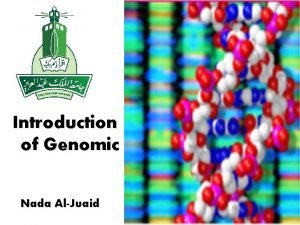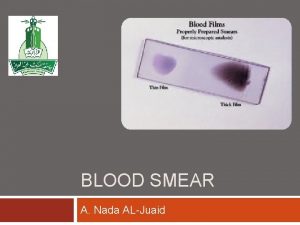LYMPHATIC SYSTEM Nada ALJuaid lymphatic system The lymphatic


















- Slides: 18

LYMPHATIC SYSTEM Nada AL-Juaid

lymphatic system The lymphatic system is part of the circulatory system,

Lymphatic system consists of: 1. 2. 3. 4. lymph Lymphatic vessels Structures and organs containing lymphatic tissue Red bone marrow

Functions of Lymphatic system Drain interstitial fluid The lymphatic system also removes excess fluid, and waste products from the interstitial spaces between the cells. Transport dietary fats absorb lipids from the intestine and transport them to the blood Carry out immune responses defend the body against disease by producing lymphocytes

Lymphatic organs and tissues A. B. Primary Lymphatic organs: Thymus gland Bone marrow Secondary Lymphatic organs: Lymph nodes Spleen Tonsils Peyer’s patches appendix

Primary Lymphatic organs Thymus gland The thymus secretes a hormone, thymosin, that causes pre-T-cells to mature (in the thymus) into T-cells.

Primary Lymphatic organs Bone marrow: marrow Is the soft tissue found in the hollow Interior bones. marrow in large bones produces new blood cells.

Bone marrow There are several different types of white blood cells are often characterized as granulocytes or agranulocytes

Bone marrow Granulocytes (polymorphonuclear leukocytes): leukocytes characterised by the presence of differently staining granules in their cytoplasm when viewed under light microscopy. There are three types of granulocytes: neutrophils, basophils, and eosinophils, which are named according to their staining properties. Agranulocytes (mononuclear leukocytes): leukocytes characterized by the apparent absence of granules in their cytoplasm. These include lymphocytes, monocytes, and macrophages.

Secondary Lymphatic organs Lymph nodes There are between 600 -700 lymph nodes present in the average human body. It is the role of these nodes to filter the lymph before it can be returned to the circulatory system. Although these nodes can increase or decrease in size throughout life, any nodes that has been damaged or destroyed, does not regenerate.

Secondary Lymphatic organs Lymph nodes Located along lymphatic vessels Covered by capsule Trabeculae divide node into compartments Contain B cells, T cells, dendritic cells, and macrophages

Secondary Lymphatic organs Spleen Connective tissue capsule with internal trabeculae The spleen behaves similar to a lymph node but instead of filtering the lymphatic fluid it filters the blood. Red Pulp: Clusters of Macrophages and Red Blood Cells. White Pulp: Lymphocytes and Macrophages,

Secondary Lymphatic organs Tonsils area of lymphoid tissue on either side of the throat. Tonsils refers to the Palatine tonsils, that can be seen on the left and right sides at the back of the throat.

Secondary Lymphatic organs Tonsils : helping fight off pharyngeal and upper respiratory tract infections. Other types are pharyngeal tonsils and lingul tosils

Secondary Lymphatic organs Peyer’s patches Peyer's patches are lymphoid follicles located in the wall of the small intestine.

Secondary Lymphatic organs appendix


References http: //www. lymphnotes. com/article. php/id/151/ http: //www. emc. maricopa. edu/faculty/farabee/ biobk/biobookimmun. html http: //pms. meridianschools. org/Ch%2016%20 Section%202%20 Notes. pdf
 Nada enharmonis dengan
Nada enharmonis dengan Genocida
Genocida Nada te turbe taize letra
Nada te turbe taize letra Salmo que nada te turbe
Salmo que nada te turbe Santa teresa nada te turbe
Santa teresa nada te turbe Nada des enharmonis dengan nada.
Nada des enharmonis dengan nada. Estamos aqui de passagem nada trouxemos e nada levaremos
Estamos aqui de passagem nada trouxemos e nada levaremos Mateo 25 14
Mateo 25 14 Salmo 37 7 nada te turbe
Salmo 37 7 nada te turbe Nada te turbe
Nada te turbe Lymphatic system vs endocrine system
Lymphatic system vs endocrine system Lymphatic system
Lymphatic system Hình ảnh bộ gõ cơ thể búng tay
Hình ảnh bộ gõ cơ thể búng tay Bổ thể
Bổ thể Tỉ lệ cơ thể trẻ em
Tỉ lệ cơ thể trẻ em Voi kéo gỗ như thế nào
Voi kéo gỗ như thế nào Tư thế worm breton
Tư thế worm breton Bài hát chúa yêu trần thế alleluia
Bài hát chúa yêu trần thế alleluia





























